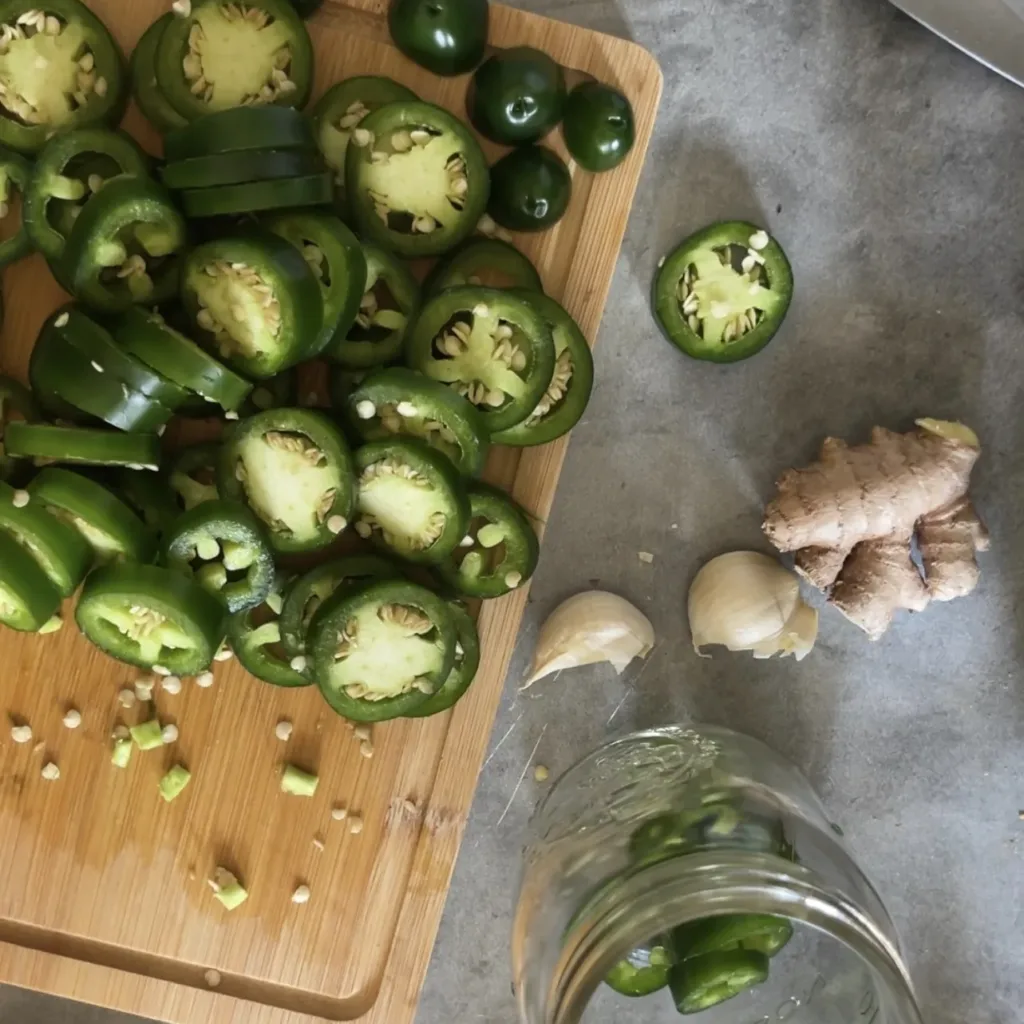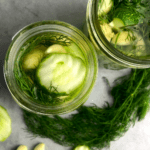Pickled jalapeños are a delicious way to add some heat and tang (the pros call it “acidity”) to your favorite dishes – think salads, tacos, sandwiches, dips, chilis. They’re easy to make and can be customized to your taste preferences. In this blog post, we’ll walk you through a simple recipe for pickled jalapeños that’s just right for beginner picklers.
Your grocery list for pickled jalapeños
Produce
- Jalapeños
- Garlic
- Ginger (optional)
Pantry Items
- White distilled or apple cider vinegar
- Sugar
- Kosher salt
- Black peppercorns (optional)
- Big M’s vinegar-based BBQ sauce (local product)
Equipment/tools you’ll need
- Large measuring cup or small saucepan (for warming pickling liquid)
- Measuring spoons
- Mason jars
What is pickling?
Pickling is a process of preserving food by immersing it in a solution of acid, such as vinegar or lemon juice, along with the addition of salt, sugar, and various spices. The acid and salt in the pickling solution create an environment that inhibits the growth of bacteria, yeast, and molds, thereby extending the shelf life of the food.
Benefits of pickling
Overall, pickling not only helps in preserving food but also adds interesting flavors, textures, and health benefits to a wide range of ingredients.
- Preservation: Pickling helps to extend the shelf life of perishable foods, allowing them to be stored for longer periods without spoiling.
- Flavor enhancement: The pickling process infuses the food with the flavors of the pickling solution and the added spices, resulting in a tangy, sweet, or savory taste.
- Nutritional value: Pickling can help retain the nutritional value of foods, as the preservation process involves minimal heat and cooking time. Vitamins and minerals present in the food may be retained during pickling.
- Probiotics: Fermented pickles, such as sauerkraut and kimchi, contain beneficial bacteria known as probiotics. These bacteria can aid in digestion and promote a healthy gut.
- Versatility: Pickling can be done with a wide variety of foods, including fruits, vegetables, meats, and eggs. This allows for the preservation and enjoyment of seasonal produce throughout the year.
- Texture and crunch: Pickling can add a unique texture and crunch to foods, transforming their texture and making them more enjoyable to eat.
- Flavor development: The pickling process allows the flavors of the ingredients to meld together over time, resulting in complex and well-balanced flavors.
- Homemade option: Pickling is a popular method for preserving foods at home. It allows individuals to control the ingredients, flavors, and level of preservation to suit their preferences.
Four basic ingredients in a pickling liquid
- apple cider or white distilled vinegar – Used in all sorts of food preservation methods. The flavor of the pickle will vary slightly based on the type of vinegar used.
- water – To cut the vinegar.
- sugar – Adds flavor and balances the acidity from the vinegar. Optional, but recommended
- kosher salt – For flavor and aids in preservation process.
Step-by-step instructions for making pickled jalapeños
- Prepare the Jalapenos: Start by washing the jalapenos really well. You can choose to remove the stems or leave them on, depending on your preference. Slice the jalapenos into desired thickness (slices or rings). Remove some or most of the seeds, depending on your tolerance to spice.
- Sterilize Jars: Sterilize glass jars and lids by boiling them in water for a few minutes or by running them through a dishwasher cycle. This helps to ensure that the jars are clean and free from any bacteria.
- Make the Pickling Liquid: In a saucepan, combine equal parts of water and vinegar. You can use white vinegar or apple cider vinegar. Add salt, sugar, and any desired spices or herbs to the mixture. Bring the mixture to a boil and stir until the sugar and salt are fully dissolved.
- Pack the Jars: Carefully pack the sliced jalapenos into the sterilized jars, leaving some headspace at the top. You can add additional spices, such as garlic cloves, to enhance the flavor. Make sure to pack the jalapenos tightly.
- Pour the Pickling Liquid: Pour the hot pickling liquid over the jalapenos in the jars, making sure to cover them completely. Leave a small amount of headspace at the top of the jar.
- Seal the Jars: Wipe the rims of the jars to remove any liquid or residue. Place the lids on the jars and tighten the rings. Ensure that the jars are properly sealed.
- Process the Jars (Optional): If you want to store the pickles for a longer period of time, you can process the jars in a water bath canner. Place the jars in a large pot of boiling water, making sure they are fully submerged. Process for the recommended amount of time based on your altitude and the size of the jars.
- Cool and Store: Allow the jars to cool completely before storing them in a cool, dark place. The pickles will need some time to develop flavor, so it’s best to wait at least a week before consuming them.
Tips for a great jar of pickled jalapeños
Use fresh jalapenos
Choose jalapenos that are firm and free from any blemishes or soft spots.
Wear gloves
Jalapenos can be quite spicy, so wearing gloves will protect your hands from the heat.
Slice them evenly
Slice the jalapenos into even-sized rings or strips to ensure they pickle evenly.
Adjust the spice level
If you prefer milder pickled jalapenos, remove the seeds and white membrane before pickling. Leave them in for more of a kick.
Add different flavors
Customize your pickled jalapenos by adding other ingredients like garlic, onions, ginger, black or pink peppercorns, and/or other spices to enhance the flavor.
Sterilize your jars
It’s important to sterilize your jars before pickling to prevent any bacteria from growing. You can do this by boiling the jars and lids or running them through a dishwasher cycle.
Pack the jars tightly
Pack the sliced jalapenos tightly into the jars to get as many jalapenos and seasonings as possible.
Have patience
Let them pickle! Seal the jars and let the pickled jalapenos sit at room temperature for at least 24 hours to allow the flavor to develop.
What else can I pickle?
- Cucumbers (these make traditional pickles)
- Brussels sprouts
- Asparagus
- Green beans
- Garlic
- Green tomatoes
- Cabbage
- Peppers (such as Hungarian hot peppers or jalapenos)
- Peaches
- Beets
- Berries (such as strawberries or blueberries)
- Onions
- Squash
- Carrots
- Radishes
These are just a few examples, but there are many other fruits, vegetables, and even meats that can be pickled. The possibilities are pretty much endless!
Pickled Jalapeños
Equipment
- Small saucepan or large microwaveable container
- Mason jars
- Measuring cups and spoons
Ingredients
- 10-12 jalapeños sliced, stems discarded, and some seeds removed
- 2 cloves garlic smashed and peeled
- 1 knob of diced ginger peeling optional
- 1¼ cup vinegar
- 1¼ cup filtered water
- 2 tablespoons of Big M's BBQ sauce
- 1/4 cup sugar
- 2 tablespoons kosher salt
Instructions
- In a medium saucepan combine sugar, salt, garlic, water and vinegar.
- Heat to a boil, stirring to dissolve the sugar and salt. Once at a boil; add the sliced jalapenos pressing them so they are submerged under the pickling liquids. Remove the pot off of the heat and let them sit for 10-15 minutes.
- Use tongs to transfer the jalapenos into a clean jar. Ladle the pickling juices over top until you've reached the top of the jar. Let cool at room temperature before securing a lid and popping them into the fridge.
Notes
This is not a canning recipe therefore NOT shelf stable and will need to be kept refrigerated.
I recommend treating these as I would any opened jar of jalapenos. They should last a long while if kept refrigerated in the airtight jar.
If looking for canning instructions or directions, follow the USDA guidelines.



